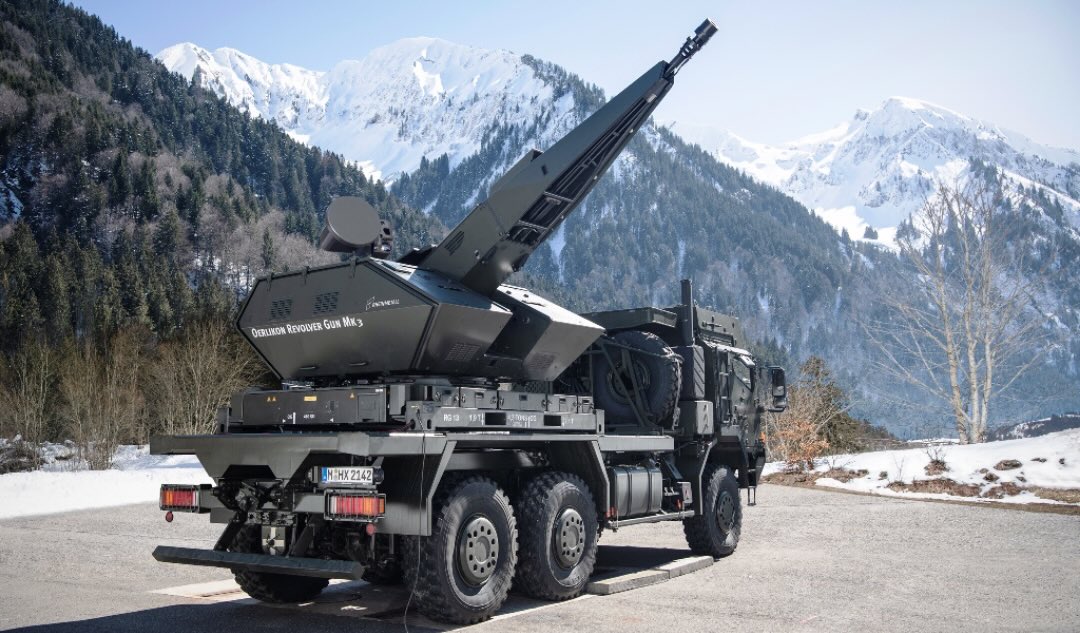


The video, published on 12 July, captures the destruction of seven unmanned aerial vehicles (UAVs), highlighting the system’s precision and operational success during one of the largest drone assaults recorded since the beginning of the full-scale invasion.
The footage was made public by Ukraine’s Air Force Command, though the location and exact timing of the engagement have not been disclosed for security reasons. In an accompanying statement, military officials confirmed that the engagement was successful, describing the results as “flawless” in terms of target elimination.
Skynex, developed by German defence contractor Rheinmetall, is a short-range air defence system designed primarily to counter low-flying aerial threats such as UAVs, cruise missiles, and aircraft. It employs automatic 35mm cannons and an advanced radar system capable of targeting small, fast-moving objects. According to the Ukrainian Air Force, the effective engagement range of the system is approximately four kilometres.
Ukraine’s Air Force spokesperson Yurii Ihnat stated that the overnight attack preceding 12 July marked a new high in the scale of drone usage by Russia. In total, 319 Shahed drones were launched, alongside 25 Kh-101 cruise missiles, bringing the total number of aerial targets intercepted that night to 344.
The Shahed-131 and Shahed-136 drones, repurposed and rebranded by Russia as Geran-1 and Geran-2 respectively, have been a recurring feature of Moscow’s long-range strike strategy against Ukrainian cities and infrastructure. Although relatively low-cost, these loitering munitions are designed to cause psychological disruption as well as physical damage. Their widespread use in swarm formations poses challenges to traditional air defence systems.
Ukraine has been steadily integrating Western-supplied air defence assets into its networked defence infrastructure. The deployment of the Skynex system is part of a broader trend aimed at closing gaps in low-altitude drone defence. The system is reportedly designed to operate in conjunction with other assets such as radar stations and command-and-control platforms, allowing for coordinated, layered responses to aerial threats.
The Skynex platform is considered especially suitable for urban and infrastructure protection roles due to its automatic tracking, rapid-fire capability, and modular setup, which allows for flexible deployment. Rheinmetall’s product is intended to fill a niche between larger systems like IRIS-T and Patriot, and smaller mobile units such as Gepard.
Although details of Skynex deliveries to Ukraine have not been formally disclosed by the German government, reports in late 2023 and 2024 indicated that Berlin had approved several packages of military assistance including air defence components. Rheinmetall has also expanded its production capacity and cooperation with Ukrainian defence authorities, with plans for domestic assembly of key systems reportedly under way.
The record-breaking use of Shahed drones on the night of 12 July reflects a continuing Russian emphasis on low-cost, high-volume attacks designed to overwhelm Ukrainian air defences. However, Ukrainian officials suggest that recent performance indicators, including the successful use of Skynex, point to increased effectiveness in intercepting such threats.
According to open-source intelligence and prior Air Force statements, Ukraine’s layered air defence approach involves integrating systems of varying range and capabilities, including NASAMS, IRIS-T, S-300, and the Skynex platform. By adapting tactics and leveraging Western technologies, Ukrainian forces have succeeded in reducing the strike effectiveness of Russian UAVs and missiles in recent months.
As the war enters its third year, the development and deployment of drone-resistant air defence systems remain a key priority for Ukraine. In parallel, the increasing sophistication and frequency of drone strikes have raised questions about future escalation and the ongoing evolution of aerial warfare. Analysts note that while systems like Skynex can counter existing threats effectively, continued investment and innovation will be necessary to address the changing dynamics of drone-based attacks.
The Air Force’s decision to publicise Skynex in action appears to serve both operational and strategic purposes—highlighting the system’s technical capabilities while signalling to domestic and international audiences that Ukraine remains determined to defend its airspace through continued modernisation and allied cooperation.